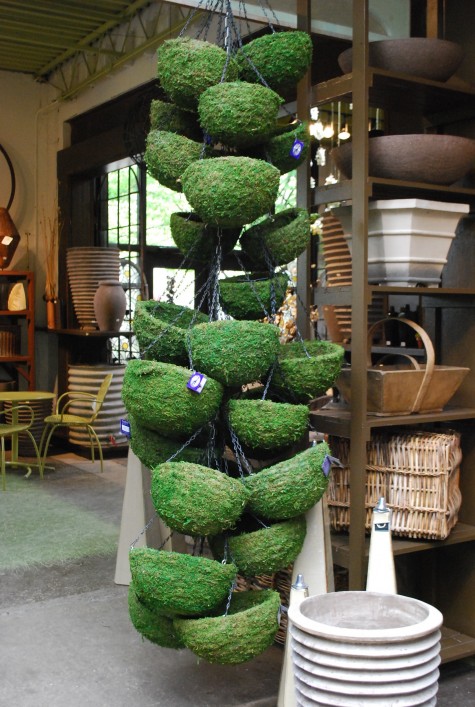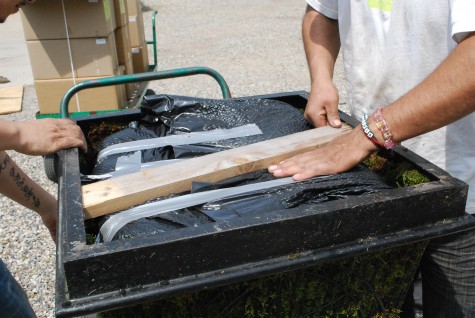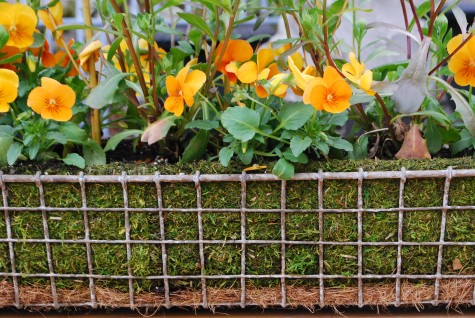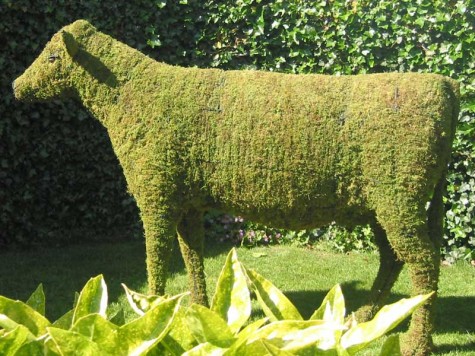Yesterday was my first indoor holiday installation. A client with an event coming up the first week of December wanted the bones of her holiday decor in place before Thanksgiving. This pair of topiaries began with moss mat glued over foam cones. The spiral garlands of reindeer moss, accompanied by a delicate silver wire garland took some time and patience to glue up, but the result is festive and elegant. The formal dining room sideboard fresh decor can be added just before the event. Fresh materials at the holiday look and smell great, but I like adding them at the last minute. Holiday ornament like this-tall, thin, and taking up little space-can be used in lots of different places. Perhaps next year’s decor will call for them on a mantel.
The breakfast room has an entirely different feeling than the formal dining room. A garland studded with faux fruit is draped over the Welsh cupboard. We filled her wood trough with lots of the same fruit. This room is ready for the last minute addition of fresh greens, and candles.
This pair of mossed cubes were topped with coulter pine cones, and variegated English boxwood. Pinus coulteri is native to southern California and northern Mexico. It produces the largest cones of any pine. They can grow to a length of 16 inches, and weigh 10 pounds a piece. I thought this pair of sculptures would look appropriate in the library.

The moss mat was applied over dry floral foam, making it easy to glue the heavy cones in an upright position, and insert the springs of boxwood. They have a comfortably masculine look that is appropriate for the room.
We paid lots of holiday oriented attention to the foyer. The moment a guest arrives, what they see first creates a lasting impression. This is why I devote so much attention to the landscape of the driveway. The end of my drive is the foyer of my garden. I come home every day, and I want what I see first when I get there to be beautiful and inviting. Decorating the foyer mirror and sconces means there is plenty of room on the table for family pictures, a holiday hostess gift, or a tray of champagne. The oval magnolia wreath we made by gluing individual leaves over a foam form; the size and shape is friendly to the mirror. A small suction cup provides a hook; the wreath weighs very little. The sconces have glass ornament, silvery picks, silver fabric leaves, and magnolia wired to them.
We dressed the staircase in a long needled faux pine garland. We added glass holiday ornaments, glittered wire flower ornaments, and silvery pine picks for a soft and dressy look. The result is beautiful and elegant. The garland is affixed to the outside of the railing with black zip ties-this is friendly to the wood finish on the railing. In between each length of garland-a pine pick of the same style. This helps make a graceful transition from one garland swag to the next. Most faux garlands are 6 feet long-which may or may not work with the length of your staircase. The added picks helps to make the garland fit the space.
The living room fireplace mantel is short, with little depth. We attached overlapping bunches of preserved and whitewashed eucalyptus to a bamboo pole, cut to a length just shy of the width of this mantle. We dressed that eucalyptus with silver fir greens, sparkly picks, and just a pair of bleached cones. Those cones address in a subtle way the color of the brass fireplace fender.
The result is mindful of the elaborate carving on the mantel, and formal presentation of the fireplace. Not every mantel asks for holiday garland that goes to the floor. We will add a fresh and decorated wreath to the space above the fireplace, just before the event. That wreath will be concolor and noble fir; both of these greens keep indoors over the course of the holiday.

The fresh fir garland over the front door will stay fresh, given that the air temperature is cold. The glass ornaments have had their caps glued on, to keep moisture out. Not seen in this picture, a massive second story overhang supported by columns that will protect the glass from too much exposure to the weather. The pots at the front door-this we will do next week. This holiday project is well underway.


















